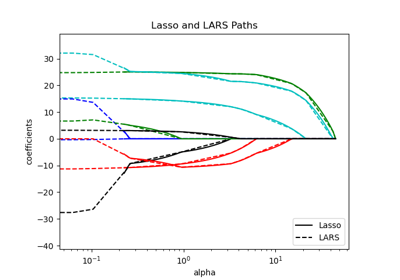lars_path#
- sklearn.linear_model.lars_path(X, y, Xy=None, *, Gram=None, max_iter=500, alpha_min=0, method='lar', copy_X=True, eps=np.float64(2.220446049250313e-16), copy_Gram=True, verbose=0, return_path=True, return_n_iter=False, positive=False)[source]#
Compute Least Angle Regression or Lasso path using the LARS algorithm.
The optimization objective for the case method=’lasso’ is:
(1 / (2 * n_samples)) * ||y - Xw||^2_2 + alpha * ||w||_1
in the case of method=’lar’, the objective function is only known in the form of an implicit equation (see discussion in [1]).
Read more in the User Guide.
- Parameters:
- XNone or ndarray of shape (n_samples, n_features)
Input data. If X is
None, Gram must also beNone. If only the Gram matrix is available, uselars_path_graminstead.- yNone or ndarray of shape (n_samples,)
Input targets.
- Xyarray-like of shape (n_features,), default=None
Xy = X.T @ ythat can be precomputed. It is useful only when the Gram matrix is precomputed.- GramNone, ‘auto’, bool, ndarray of shape (n_features, n_features), default=None
Precomputed Gram matrix
X.T @ X, if'auto', the Gram matrix is precomputed from the given X, if there are more samples than features.- max_iterint, default=500
Maximum number of iterations to perform, set to infinity for no limit.
- alpha_minfloat, default=0
Minimum correlation along the path. It corresponds to the regularization parameter
alphain the Lasso.- method{‘lar’, ‘lasso’}, default=’lar’
Specifies the returned model. Select
'lar'for Least Angle Regression,'lasso'for the Lasso.- copy_Xbool, default=True
If
False,Xis overwritten.- epsfloat, default=np.finfo(float).eps
The machine-precision regularization in the computation of the Cholesky diagonal factors. Increase this for very ill-conditioned systems. Unlike the
tolparameter in some iterative optimization-based algorithms, this parameter does not control the tolerance of the optimization.- copy_Grambool, default=True
If
False,Gramis overwritten.- verboseint, default=0
Controls output verbosity.
- return_pathbool, default=True
If
True, returns the entire path, else returns only the last point of the path.- return_n_iterbool, default=False
Whether to return the number of iterations.
- positivebool, default=False
Restrict coefficients to be >= 0. This option is only allowed with method ‘lasso’. Note that the model coefficients will not converge to the ordinary-least-squares solution for small values of alpha. Only coefficients up to the smallest alpha value (
alphas_[alphas_ > 0.].min()when fit_path=True) reached by the stepwise Lars-Lasso algorithm are typically in congruence with the solution of the coordinate descentlasso_pathfunction.
- Returns:
- alphasndarray of shape (n_alphas + 1,)
Maximum of covariances (in absolute value) at each iteration.
n_alphasis eithermax_iter,n_features, or the number of nodes in the path withalpha >= alpha_min, whichever is smaller.- activendarray of shape (n_alphas,)
Indices of active variables at the end of the path.
- coefsndarray of shape (n_features, n_alphas + 1)
Coefficients along the path.
- n_iterint
Number of iterations run. Returned only if
return_n_iteris set to True.
See also
lars_path_gramCompute LARS path in the sufficient stats mode.
lasso_pathCompute Lasso path with coordinate descent.
LassoLarsLasso model fit with Least Angle Regression a.k.a. Lars.
LarsLeast Angle Regression model a.k.a. LAR.
LassoLarsCVCross-validated Lasso, using the LARS algorithm.
LarsCVCross-validated Least Angle Regression model.
sklearn.decomposition.sparse_encodeSparse coding.
References
[1]“Least Angle Regression”, Efron et al. http://statweb.stanford.edu/~tibs/ftp/lars.pdf
Examples
>>> from sklearn.linear_model import lars_path >>> from sklearn.datasets import make_regression >>> X, y, true_coef = make_regression( ... n_samples=100, n_features=5, n_informative=2, coef=True, random_state=0 ... ) >>> true_coef array([ 0. , 0. , 0. , 97.9..., 45.7...]) >>> alphas, _, estimated_coef = lars_path(X, y) >>> alphas.shape (3,) >>> estimated_coef array([[ 0. , 0. , 0. ], [ 0. , 0. , 0. ], [ 0. , 0. , 0. ], [ 0. , 46.96..., 97.99...], [ 0. , 0. , 45.70...]])

